Calcium Chloride
-
- Gulf Fleet's 102nd Vessel Is Powered By EMD Diesels Maritime Reporter, Feb 15, 1981 #6
Gulf Fleet Marine Corporation has accepted delivery of the Gulf Fleet No. 44 (shown above), a 190 by 40 by 14-foot towing' supply vessel. She was built in Houma, La., by Quality Shipyards, Inc., another Gulf Fleet company, and r e p r e s e n t s t h e 102nd vessel in this rapidly growing fleet.
Powered by twin GM Electro- Motive Division 16-645E2 diesel engines that develop a total of 3,900 bhp at 900 rpm through Reintjes WAV 481 3:1 reduction gears, this vessel is capable of sustaining speeds up to 13 knots.
The No. 44 has a clear deck space of 96 by 32 feet, with a maximum deck cargo capacity of 522 long tons. Underdeck, she can carry up to 520 tons of drill water.
The vessel has bulk tanks with a 5,800-cubic-foot capacity, as well as liquid mud tanks with a 1,250-barrel capacity that provide for the carriage of 189 tons of liquid mud. Also provided in this versatile vessel are 1,250- barrel calcium chloride tanks.
Its towing package consists of a double drum SMATCO 66 DAW 200 towing winch with a drum capacity of 2,500 feet of 2-inch cable on each drum, and a 5-foot by 8-foot stern roller. With a measured bollard pull of 70,000 pounds, this vessel is classed by the American Bureau of Shipping as +A-1 (AMS), All Ocean Towing, and is built in accordance with specifications of the United States Coast Guard.
Gulf Fleet president Richard M. Currence attributes a great deal of the success and strength of the company to an extremely active construction program that he anticipates will continue. Gulf Fleet Marine provides a wide range of services to meet the needs of the offshore petroleum and offshore construction industries, and is one of the Houston Natural Gas group of companies.
-
- Twin Towing/Supply Vessels Delivered By Quality Shipyards Maritime Reporter, Jan 15, 1981 #8
of liquid mud, which can be transferred at a rate of 600-800 gallons per minute at 170 feet. Each vessel also is fitted with 1,250-barrel-capacity calcium chloride tanks. The vessels are equipped with a towing package that consists of a SMATCO 66 DAW 200 double- drum towing winch with a drum capacity
-
- St. Louis Ship Delivers 6,000-HP Towing/Supply Boat To Gulf Fleet Marine Maritime Reporter, Oct 1983 #10
,030 U.S. gallons. The vessel has six bulk tanks with maximum capacity of 6,320 cubic feet and she may carry drilling fluids including liquid mud, calcium chloride and calcium bromide up to 1,524 barrels. The Gulf Fleet No. 65 was built by St. Louis Ship, a division of Pott Industries, and represents
-
- Quality Delivers Towing/Supply Vessel To Gulf Fleet Marine Maritime Reporter, Sep 15, 1980 #18
hour. The vessel is fitted with liquid mud tanks with 1,250- barrel capacity, which can be transferred at a rate of 600-800 gpm at 170 feet head. Calcium chloride tanks also provide a capacity of 1,250 barrels. The Gulf Fleet No. 41 has a SMATCO 66 DAW200, doubledrum towing winch with a capacity of
-
- Blount Marine Delivers Offshore Supply Vessel Maritime Reporter, Jun 1980 #10
West to Hamilton, Inc. of Panama City, Fla. The vessel admeasures under 200 gross tons, and is equipped to carry up to 600 long tons of combined calcium chloride or liquid mud and deck cargo. Clear deck length inboard is 114 feet, with a clear inboard beam of 30 feet 8 inches. Her four mud tanks have
-
- Twin-Screw Supply Vessel Delivered By Bender Shipbuilding Maritime Reporter, Jan 15, 1981 #12
, and storeroom. Compressed air is provided by two Quincy D310 compressors, each driven by a 2-hp electric motor. The 300-barrel liquid mud or calcium chloride system consists of two pumps, each driven from the front of the 4-71 generator diesels through Funk 1:1, reversing c l u t c h e d pump drives
-
- New Supply/Fire-Fighting Vessel Delivered To Gulf Fleet Marine Maritime Reporter, Apr 15, 1981 #20
gears. Equipped with four bulk tanks with a total capacity of 4,000 cubic feet, the Gulf Fleet No. 45 can carry 1,250 barrels of liquid mud or calcium chloride that can be transferred at a rate of 550 gpm at 180 feet, and can carry 141,360 gallons of drill water that can be transferred at a rate of
-
- America’s First Marine Highway Comes Back to Life Marine News, Apr 2014 #40
System, with the vast majority of these aids being unlighted. Products still shipped on the Canal System include pre-fabricated rebar caissons, liquid calcium chloride, radar dome material, commercial paper dryers, aggregate, turbines, commercial boilers, transformers, and other over-sized cargo. On the Water It
-
- A Review OUTSTANDING U.S. SHALLOW DRAFT VESSELS OF 1980 Maritime Reporter, Jan 1981 #14
West to Hamilton, Inc. of Panama City, Fla. The vessel admeasures under 200 gross tons, and is equipped to carry up to 600 long tons of combined calcium chloride or liquid mud and deck cargo. Clear deck length inboard is 114 feet, with a clear inboard width of 30 feet 8 inches. Her four mud tanks have
-
- Gulf Coast Shipyards Maritime Reporter, Apr 1985 #78
that ways is a 165-foot supply belonging to Cheramie Brothers that is being lengthened to 186 feet. A 21-foot midbody to carry liquid mud and calcium chloride is being prefabbed and will be installed forward of the engine room. A bow thruster and two 500-cubic-foot bulk mud tanks are also being installed
-
 )
March 2024 - Marine Technology Reporter page: 35
)
March 2024 - Marine Technology Reporter page: 35Figure 1 A self-righting vehicle design with buoyancy high and weight low, WHOI’s SeaBED AUV captures the attention of a pair of curious Antarctic penguins as it is deployed from the British research vessel James Clark Ross. Vehicle designers allowed for temperature reduction of battery capacity. Recharge
-
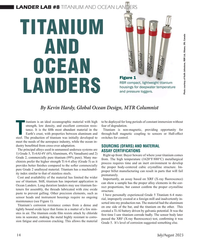 )
July 2023 - Marine Technology Reporter page: 14
)
July 2023 - Marine Technology Reporter page: 14LANDER LAB #8 TITANIUM AND OCEAN LANDERS TITANIUM AND OCEAN Figure 1 RBR compact, lightweight titanium housings for deepwater temperature and pressure loggers. LANDERS Photo courtesy of Keith Johnstone, RBR Ltd, Ottawa, ON, Canada By Kevin Hardy, Global Ocean Design, MTR Columnist itanium is an ideal
-
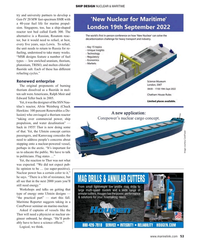 )
September 2022 - Maritime Reporter and Engineering News page: 53
)
September 2022 - Maritime Reporter and Engineering News page: 53SHIP DESIGN NUCLEAR & MARITIME try and university partners to develop a Gen-IV 20 MW fast-spectrum SMR with a 40-year fuel life for marine propul- sion. Singapore, too, has a ship-shaped reactor test bed called Earth 300. The alternative is a Russian, Rosatom reac- tor, but it would need to refuel
-
 )
September 2022 - Maritime Reporter and Engineering News page: 52
)
September 2022 - Maritime Reporter and Engineering News page: 52SHIP DESIGN NUCLEAR & MARITIME They’re also being called small “Thor is a very large investment,” says module (or multi-modular) reactors Ruud. “The customer is probably not ABS, DOE to Examing Nuclear (SMRs). “As an energy source, SMRs the shipowner.” Energy for Maritime provide the ? exibility to
-
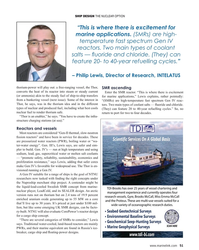 )
September 2022 - Maritime Reporter and Engineering News page: 51
)
September 2022 - Maritime Reporter and Engineering News page: 51SHIP DESIGN THE NUCLEAR OPTION “This is where there is excitement for marine applications. (SMRs) are high- temperature fast spectrum Gen IV reactors. Two main types of coolant salts — ? uoride and chloride. (They) can feature 20- to 40-year refuelling cycles.” – Philip Lewis, Director of Research
-
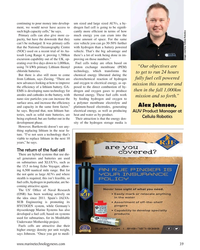 )
July 2022 - Marine Technology Reporter page: 39
)
July 2022 - Marine Technology Reporter page: 39continuing to pour money into develop- um sized and large sized AUVs, a hy- ment, we would never have access to drogen fuel cell is going to be signi? - such high capacity cells,” he says. cantly more ef? cient in terms of how Primary cells can also give more ca- much energy you can cram into the
-
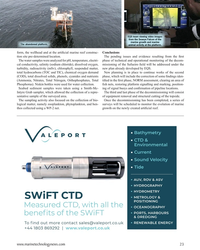 )
July 2022 - Marine Technology Reporter page: 23
)
July 2022 - Marine Technology Reporter page: 23EQ EQ EQS EQ E EQ team vie ing video imag s s s sEQS team viewingv ideoi mageses from the Seaeye Falcon of the marine growth and marine m m m Th Th he The Th he abandoned platform. T T T T Th he e abandonedp p p plat orm m m. . . fo m m. activit ity ac a mal ac an ani ani an ani animal activity animal
-
 )
June 2022 - Maritime Reporter and Engineering News page: 15
)
June 2022 - Maritime Reporter and Engineering News page: 15back to combustible or mis-declared cargos in containers, including batteries, charcoal and chemicals such as calcium hypochlorite, an ingredient in cleaning products. In March 2022, the US Coast Guard (USCG) issued a safety alert about the risk posed by lithium batteries following two separate container
-
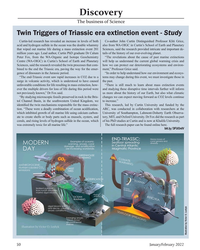 )
January 2022 - Marine Technology Reporter page: 50
)
January 2022 - Marine Technology Reporter page: 50deadly combination of ocean acidi? cation, ARC, was conducted in collaboration with researchers at the which inhibited growth of all marine life using calcium carbon- University of Southampton, Lahmont-Doherty Earth Observa- ate to create shells or body parts such as mussels, oysters, and tory, MIT, and
-
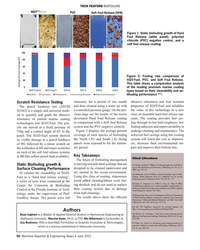 )
June 2021 - Maritime Reporter and Engineering News page: 50
)
June 2021 - Maritime Reporter and Engineering News page: 50TECH FEATURE BIOFOULING Figure 1: Static biofouling growth of Hard Foul Release (white panel), polyvinyl chloride (PVC) negative control, and a soft foul release coating. Figure 2: Fouling rate comparison of XGIT-Fuel, PVC, and Soft Foul Release. This table shows a comparative analysis of the leading
-
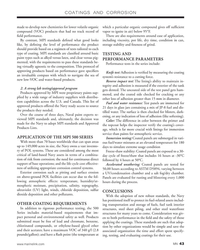 )
October 2020 - Marine News page: 43
)
October 2020 - Marine News page: 43COATINGS AND CORROSION made to develop new chemistries for lower volatile organic which a particular organic compound gives off suf? cient compound (VOC) products that had no track record of vapor to ignite in air) below 95*F. ? eld performance. There are also requirements around ease of application
-
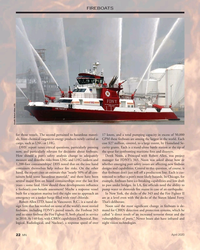 )
April 2020 - Marine News page: 22
)
April 2020 - Marine News page: 22FIREBOATS Credit: Robert Allen, LTD. for those vessels. The second pertained to hazardous materi- 17 knots, and a total pumping capacity in excess of 50,000 als, from chemical cargoes to energy products newly carried as GPM these ?reboats are among the largest in the world. Each cargo, such as LNG or LHG.
-
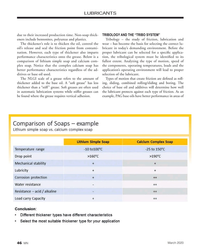 )
March 2020 - Marine News page: 46
)
March 2020 - Marine News page: 46characteristics onto the grease. Below is a tion, the tribological system must be identi? ed to its comparison of lithium simple soap and calcium com- fullest extent. Analyzing the type of motion, speed of plex soap. Notice that the complex calcium soap has the components, operating temperatures
-
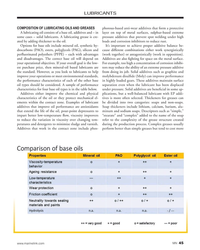 )
March 2020 - Marine News page: 45
)
March 2020 - Marine News page: 45lubricant be divided into two categories: soaps and non-soaps. additives that improve oil performance are antioxidants Soap thickeners include lithium, calcium, barium, alu- that extend the life of the oil, pour-point depressants to minum and sodium soaps. Descriptors such as “simple,” impart better low-temperat
-
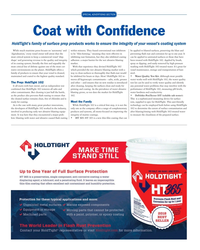 )
March 2019 - Maritime Reporter and Engineering News page: 23
)
March 2019 - Maritime Reporter and Engineering News page: 23SPECIAL ADVERTISING SECTION Coat with Con? dence HoldTight’s family of surface prep products works to ensure the integrity of your vessel’s coating system While much maritime press focuses on ‘autonomy’ and within minutes. They found conventional rust inhibitors be applied to blasted surfaces, preserving
-
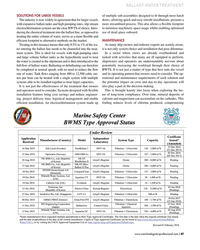 )
Jan/Feb 2019 - Maritime Logistics Professional page: 47
)
Jan/Feb 2019 - Maritime Logistics Professional page: 47savings and reduce engineer- tor of long-term compliance. Over time, mineral deposits of ing, project delivery time, logistical management and enable calcium and magnesium can accumulate on the cathodes. This effcient installation. An electrochlorination system made up fouling reduces levels of chlorine
-
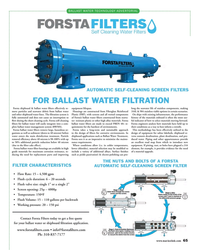 )
March 2017 - Maritime Reporter and Engineering News page: 65
)
March 2017 - Maritime Reporter and Engineering News page: 65BALLAST WATER TECHNOLOGY ADVERTORIAL AUTOMATIC SELF-CLEANING SCREEN FILTERS FOR BALLAST WATER FILTRATION Forsta shipboard & ballast water ? lters effectively re- equipment lifespan. long the seawater life of stainless components, making move particles and seawater debris from ballast water Housings are
-
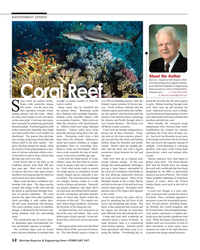 )
February 2017 - Maritime Reporter and Engineering News page: 12
)
February 2017 - Maritime Reporter and Engineering News page: 12the current until, hopefully, they alight branches. Foliose corals have broad Coral reefs are broadly categorized as Acidi? cation has leached the calcium on a hard surface like a rock suitable for plate-like portions rising above the sub- having one of three structures. Fring- carbonate out of the
-
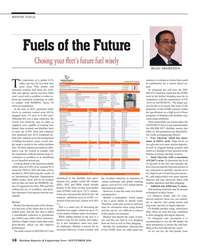 )
September 2016 - Maritime Reporter and Engineering News page: 16
)
September 2016 - Maritime Reporter and Engineering News page: 16(Zn) 0 15 mg/kg IP 501 Phosphorous (P) 0 15 mg/kg IP 501 brid fuels. Indeed, given the background • Free Glycerin, which has maxi- Calcium (Ca) 6 30 mg/kg IP 501 Acid Number 0.45 2.5 mg KOH/g ASTM D664 of falling fuel prices, many vessels sim- mum of 0
-
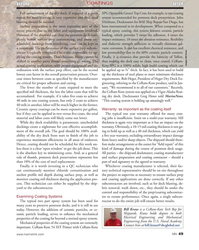 )
April 2016 - Marine News page: 49
)
April 2016 - Marine News page: 49COATINGS BEFORE AFTER Full containment of the dry dock, if required in a given SPG (Sprayable Grout) Top Coat, for example, is one coating region for sand blasting, is very expensive and thus sand system recommended for pontoon deck preservation. John blasting should be avoided. Vitzthum, Dockmaster for
-
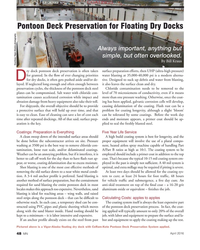 )
April 2016 - Marine News page: 48
)
April 2016 - Marine News page: 48COATINGS Pontoon Deck Preservation for Floating Dry Docks Always important, anything but simple, but often overlooked. By Bill Kraus Courtesy: Vigor-Alaska photography ry dock pontoon deck preservation is often taken surface preparation efforts, then UHP (ultra-high pressure) for granted. In the ? ow of
-
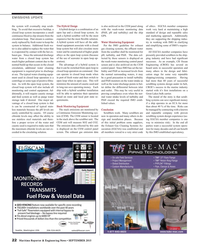 )
September 2015 - Maritime Reporter and Engineering News page: 22
)
September 2015 - Maritime Reporter and Engineering News page: 22EMISSIONS UPDATE the system will eventually stop scrub- The Hybrid Design is also archived in the CEM panel along of ethics. EGCSA member companies bing. To avoid that excessive buildup, a A hybrid design is a combination of an with the wash-water monitoring data work very hard at maintaining a high
-
 )
September 2015 - Marine Technology Reporter page: 18
)
September 2015 - Marine Technology Reporter page: 18levels of carbon dioxide in seawater cause chemical This term is correct, but somewhat misleading. Until reactions that reduce the saturation state of calcium carbon- recently, the oceans have had (so far as can be deter- ate minerals such as aragonite and calcite. Many marine or- Smined) a pH level of
-
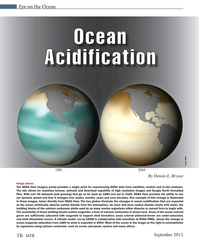 )
September 2015 - Marine Technology Reporter page: 16
)
September 2015 - Marine Technology Reporter page: 16as the ocean continually absorbs carbon dioxide from the atmosphere. As more and more carbon dioxide reacts with water, the building blocks of the calcium carbonate shells used by so many marine organisms either dissolve or cannot form to begin with. The availability of these building blocks (called
